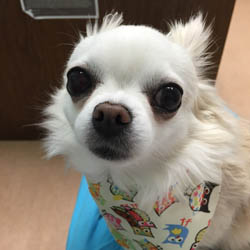 A few weeks ago a pit bull mix puppy named Topaz was brought into the shelter where I volunteer. She was in bad shape, covered in mange and very thin. But in spite of her condition, she had plenty of energy, love and personality to share with everyone around her.
A few weeks ago a pit bull mix puppy named Topaz was brought into the shelter where I volunteer. She was in bad shape, covered in mange and very thin. But in spite of her condition, she had plenty of energy, love and personality to share with everyone around her.
She was put into isolation and given medication for her mange. “Mange is a skin disease of mammals caused by parasitic mites and occasionally communicable to humans. It typically causes severe itching, hair loss, and the formation of scabs and lesions.”
She was doing well and improving. With all the precautions and excellent vet care, the staff was upset to find her very ill one morning, lethargic with vomiting and bloody diarrhea. This puppy was most likely never vaccinated as a very young pup before she came into the shelter due to neglect, ignorance or both. Who knows what this poor little girl went through before finding a safe haven.
It was determined that she had Parvo, (Canine parvovirus) a very serious, contagious and deadly disease for dogs, especially young puppies. This disease is almost always fatal if not treated immediately. It is rare that a dog comes into the shelter with Parvo so everyone was told to be extremely careful. The entire shelter was washed down with bleach and all volunteers were told to wash their hands, clothing and shoes when they got home. Only certain volunteers were allowed to interact with Topaz in full hospital gowns and gloves.
When I went home I washed my hands and clothes. I even threw out my sneakers. I immediately researched the disease because I realized I knew nothing about it. Of course all of my dogs had been vaccinated from the time they were very young pups, so I was not concerned about them getting it.
But I had a lot to learn about this deadly disease.
Within a couple of days, two of my dogs got very sick. Both Rocky and Gypsy started vomiting and had bloody diarrhea. I rushed them to my vet. Even though they were vaccinated I wanted to make sure they were okay. It turns out they were fine and felt better the next day. But I learned Parvo can (although rarely) attack even a vaccinated dog. So it is better to be safe and seek veterinary care if symptoms appear in your puppy or dog. Parvo can kill a dog in two days if not treated promptly.
Topaz survived with the excellent vet care and dedication of the volunteer staff of Peaceable Kingdom Animal Shelter.
Yesterday she was up and around wagging her tail. She still has a long way to go to a full recovery. But hopefully she will find a good home soon.
I learned the Canine parvovirus is more common and deadly then I thought it was. So please take care to get your puppies vaccinated! And make sure you see your vet once a year for a check up.
Here is some more helpful info:
What is Parvo?
Canine parvovirus is a highly contagious viral disease that can produce a life-threatening illness. The virus attacks rapidly dividing cells in a dog’s body, most severely affecting the intestinal tract. Parvovirus also attacks the white blood cells, and when young animals are infected, the virus can damage the heart muscle and cause lifelong cardiac problem
What Are the General Symptoms of Parvovirus?
The general symptoms of parvovirus are lethargy, severe vomiting, loss of appetite and bloody, foul-smelling diarrhea that can lead to life-threatening dehydration.
How Is Parvovirus Transmitted?
Parvovirus is extremely contagious and can be transmitted by any person, animal or object that comes in contact with an infected dog’s feces. Highly resistant, the virus can live in the environment for months, and may survive on inanimate objects such as food bowls, shoes, clothes, carpet and floors. It is common for an unvaccinated dog to contract parvovirus from the streets, especially in urban areas where there are many dogs.
How is Parvovirus Prevented?
The best way to prevent parvovirus is through good hygiene and vaccination. Make sure to get your puppies vaccinated, and that your adult dogs are kept up to date on their parvovirus vaccination. Talk to your veterinarian about a canine parvovirus vaccination plan that is best for your pet. Until a puppy has received its complete series of vaccinations, pet owners should use caution when bringing their pet to places where young puppies or dogs with unknown vaccination histories congregate.
For more information, visit http://pets.webmd.com/dogs/parvo-parvovirus-dogs and https://www.avma.org/public/PetCare/Pages/canine-parvovirus.aspx